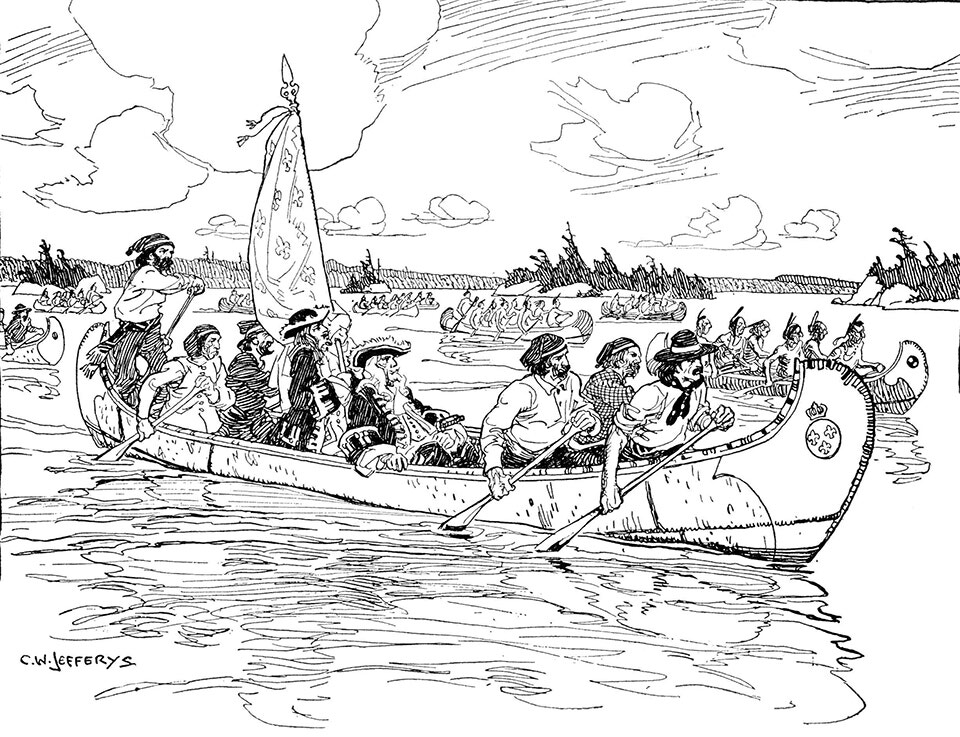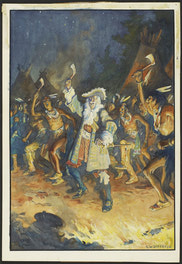Frontenac on the Way to Cataraqui, 1672
Library and Archives Canada, Acc. No. 1972-26-1366
Exhibited
- Exhibition title: Montréal plaque
tournante de latraite desfourroures . Curators: Jean Deblois, Archivesnationales du Quebec, Quebec City, Quebec; 1985.05.17 - 1985.09.02
Remarks
C.W. Jefferys' notes about this picture in Dramatic Episodes in Canada's Story
No governor of New France impressed the Indians with such respect and admiration as did Count Frontenac. He seemed to understand them instinctively, and they, in turn, appreciated his haughty and martial spirit. Frontenac shared the Indians' love of pageantry and display, as well as their regard for ceremonial observances; and his intercourse with them was conducted always with a mixture of dignified magnificence, easy familiarity and fatherly authority. The founding of Fort Frontenac was one of the first and most striking examples of his skill in dealing with the Indians. His predecessor, Courcelle, had advised the King to build a fort and trading post on Lake Ontario to curb the Iroquois, and to attract them and the Northern Indians to trade with the French rather than with the Dutch and the English to the south of the lake. Within a year after his arrival in Canada as governor Frontenac undertook to carry out the project. The time was favourable, for there was truce between the French and the Iroquois. La Salle, the future explorer of the West, who already had won Frontenac's favour, was sent to invite the Iroquois chiefs to meet the new governor at the place selected for the proposed fort and trading post. This was at the mouth of the Cataraqui river, where now stands the City of Kingston.
Late in June, 1673, Frontenac set out from Montreal on his journey up the St. Lawrence. With him there were about 400 men; habitants, voyageurs, Indians, old soldiers of the Carignan regiment, part of the garrison of Quebec, and a number of officers who volunteered for the expedition. His flotilla consisted of 120 canoes and two flat-boats painted in brilliant colours and carrying a couple of cannon. Slowly they toiled up the rapids to the smooth water of the Thousand Islands, till, on the 12th of July, they came in sight of Lake Ontario. Here Frontenac halted to arrange an impressive entrance upon the scene. All the company washed the stains of travel from their persons and dressed in their best; the Indians painted themselves and decked their hair with feathers, the officers put on their most brilliant uniforms, and the voyageurs donned their gayest sashes. Then, bright with the colour and sheen of silk, velvet, ribbons and lace and gold braid, with fluttering flags and flashing paddles dipping in time to the blare of trumpets and the roll of drums and the thunder of cannon salutes, the procession moved forward over the blue waters.
Four divisions of canoes in double lines led the way, followed by the decorated barges. Then came Frontenac and his guards, his staff and the gentlemen volunteers, with the canoes from Three Rivers on his right. and those of the Indians on his left, while two more squadrons of canoes formed the rear. Piloted by an Iroquois canoe which came out to meet them, the French entered the bay, while on the shore and along the edge of the encircling green forest, the Indians gazed in wondering admiration at the brilliant spectacle. At the point now occupied by the barracks, at the end of the present bridge, they landed and made camp.
A week was spent in councils and festivities with the Iroquois. Frontenac distributed presents of tobacco, guns and provisions. and addressed the Indians in the grandiloquent speeches they admired, promising them the protection and favour of the great King, and the advantages of profitable trade with the French if they were peaceful, and threatening them with chastisement by his powerful forces, if they were disobedient. The Iroquois were greatly impressed, as he says, "with respect, fear and good-will," and in response to his request, next year sent him several of their children to be educated at Quebec. Meanwhile, during all the parleys and entertainments. the erection of the fort proceeded rapidly and on the 27th of July, Frontenac was able to embark on his return to Montreal. By that time the fort was almost ready to house the garrison which was left to defend this western outpost of New France.
Publication References
- Jefferys, Charles W. 1930 Dramatic Episodes in Canada's Story, p. 31
-
Paterson, Gilbert. The Story of Britain and Canada. 1933 Toronto, Ryerson, 233 p. Illus., P. 143
- Jefferys, Charles W. 1934 Canada's Past in Pictures, p. 58
- Jefferys, Charles W. 1942 The Picture Gallery of Canadian History Vol 1, p. 158
- Gibbon, John Murray 1951 The Romance of the Canadian Canoe
- Bowman, Bob. Dateline: Canada. Toronto, Holt, Rinehart and Winston, 1973. n.p. Illus.
- Plummer, Kevin. “Sketching cultural nationalism.” July 18, 2009. 7 p. Illus. http://torontoist.com/2009/07/historicist_sketching_cultural_nationalism.php, p.2 - “Frontenac on the way to Cataraqui, 1763”
-
“Early Canada Historical Narratives --LOUIS DE BUADE, COMTE FRONTENAC.” Accessed July 23, 2017. http://www.uppercanadahistory.ca/finna/finna4a.html.





Comments